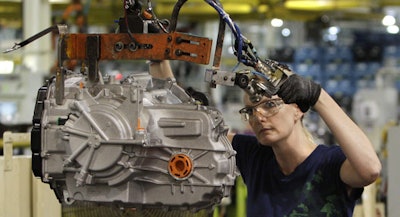
 We are living in a moment of great change for the manufacturing and logistics industries—vocational training in schools is decreasing, and workforce is tightening. Traci Fiatte, President of Staffing at Randstad says, “The baby boomers are moving out of the workforce and not being replaced.”
We are living in a moment of great change for the manufacturing and logistics industries—vocational training in schools is decreasing, and workforce is tightening. Traci Fiatte, President of Staffing at Randstad says, “The baby boomers are moving out of the workforce and not being replaced.”
I reached out to Ms. Fiatte to discuss these and other emerging trends in the manufacturing and logistics workforce. We discussed confidence levels, the skills gap, unemployment rates, talent recruitment strategies, and the hot jobs for 2015 in the manufacturing and logistics industries.
--
Bridget Bergin (BB): How would you describe the level of confidence manufacturing employees have in the strength of the economy, the number of jobs available, and their ability to find employment?
Traci Fiatte (TF): The Job Security Index shows that manufacturing and logistics workers’ sense of job security has improved quarter to quarter. 71% of the respondents feel that it is not likely they will lose their job in the next twelve months, which is a 13 point increase over the second quarter.
We have found that employees are more likely than ever to have multiple jobs simultaneously, and there is no shortage of job availability.
BB: The skills gap is a huge concern for many manufacturers. Have you noted trends in education, training, and hiring in the manufacturing sector?
TF: One of the first trends that we see is the basic supply and demand of manufacturing talent. With an overall improvement in the unemployment rate, the demand has gone up relative to supply. Another trend is the reshoring of factory jobs back to the United States. Manufacturing work is increasing, and unemployment is decreasing.
The National Center for Education statistics show that technical and vocational training in schools is decreasing. I remember having shop classes in my high school, and my children will not have that. The percentage of occupational degrees has declined 88% from 1990 to 85% in 2009. The number of vocational schools and programs are decreasing. This leads to less training in our school systems.
BB: There is an overall improvement in the unemployment rate in the manufacturing sector, dropping from 6.9% to 4.5% over the past year. Do you see this trend continuing?
TF: I absolutely see this trend continuing. Between jobs in automation that require certain skills, the trend of reshoring jobs to the U.S., and the smaller skilled workforce, I see unemployment rates continuing to drop.
BB: What can companies do to recruit a talented workforce, and what skills should individuals in the manufacturing industries hone?
TF: We looked extensively at recruiting efforts, and we found that manufacturers are beginning to see pressure from employees relating to salary. The rates of unemployment and pay increases do not correlate yet. We have seen an increase in jobs, but not an increase in pay, but that is starting to change.
Even in entry level positions, the salaries are starting to creep up, and that is what you would expect to find when demand is high and supply is low. Companies should be aware that salaries are going up and should go up. Highlighting total compensation packages inclusive of healthcare, training programs, stability of the position, etc are very important to talent.
It is also important for companies to understand which positions are in high demand and hard to fill, and then making sure those positions are seeing pay increases. We have seen some manufacturing companies increase pay for forklift operators and shipping/receiving clerks up to $1.50 an hour.
The employer’s brand and employee value proposition also become much more important. A safe, clean work environment is critical because people now have more options. When unemployment rates were higher, those types of things were overlooked.
BB: What are the hot jobs in manufacturing and logistics for 2015?
TF: It depends on how you think about it. The manufacturing jobs most in demand are assemblers and general production workers. Jobs that are both high volume and harder to fill are the C&C machine operators, quality control technicians, and production supervisors/ production team leaders.
High volume jobs in logistics are picker packers, general warehouse clerks, loader/unloaders, and drivers. Jobs that are difficult to fill are forklift operators, dispatchers, warehouse supervisors, and shipping/receiving clerks.
--
Changes in skill requirements, vocational training, and job availability have caused new trends to emerge. For more information, check out the Randstad website.























